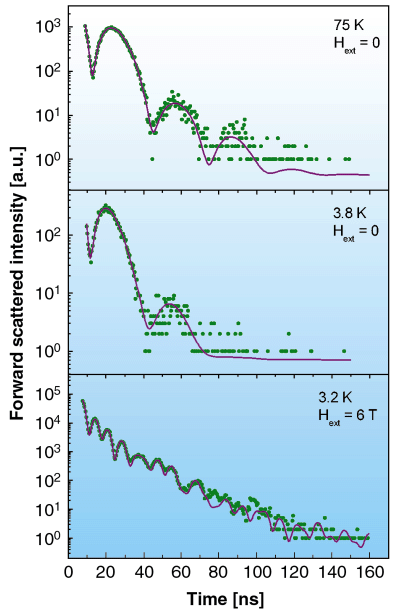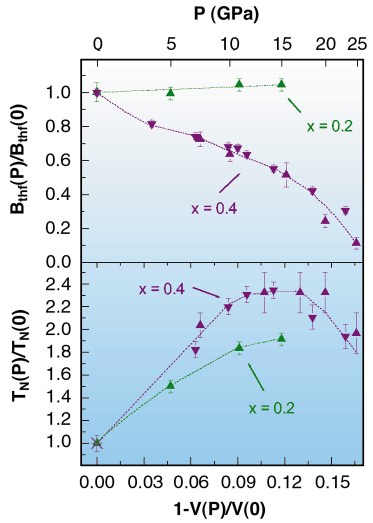- Home
- Users & Science
- Scientific Documentation
- ESRF Highlights
- ESRF Highlights 2002
- High Resolution and Resonance Scattering
- Magnetic Instability in U(In1-xSnx)3 under High Pressure
Magnetic Instability in U(In1-xSnx)3 under High Pressure
The variety of ground state properties of strongly correlated 5f electron systems, such as those of the family UX3 (X being an element of the groups IIIA or IVA of the periodic table), are determined by a competition between the indirect exchange interaction between the localised 5f electrons and the conduction electrons and their strong hybridisation with the conduction electrons of the ligands. This is well demonstrated by the broad spectrum of magnetic properties of the compounds UX3. Within this family of compounds, the series U(In1-xSnx)3, crystallising in the cubic AuCu3 structure, is particularly interesting because the substitution of Sn for In practically does not alter the unit cell volume, but determines the strength of the f-ligand hybridisation. The phase diagram of U(In1-xSnx)3 [1]shows that upon increasing the Sn concentration a transition occurs from long-range antiferromagnetic order (0  x
x  0.45) to a non-magnetic state (x
0.45) to a non-magnetic state (x  0.45), in which the system exhibits heavy fermion behaviour.
0.45), in which the system exhibits heavy fermion behaviour.
In order to gain more information on the nature of 5f magnetism, the role of f-ligand hybridisation, as well as the formation of the heavy fermion state, external pressure can be used, with the result of changing the unit cell volume without altering the electronic configuration of the ligand. We have therefore performed high-pressure experiments using 119Sn nuclear forward scattering (NFS) of synchrotron radiation in a diamond anvil cell. Using such a technique the effect of pressure on the magnetic properties of the system can be investigated through the transferred magnetic hyperfine field (Bthf) at the 119Sn nuclei, which is determined by the magnitude of the U 5f moment, ordering temperature and the spin structure of the system.
 |
|
|
The measurements were performed at beamline ID18 in the 16-bunch mode of operation of the storage ring. Figure 63 shows typical NFS spectra. Figure 64 shows the volume dependence of Bthf (at T  5.6 K) and the Néel temperature TN for the two compounds with x = 0.2 and 0.4. For x = 0.2, Bthf shows almost no dependence on pressure up to 15 GPa while TN shows a monotonic increase with pressure. Whereas when x = 0.4, Bthf decreases monotonically with increasing pressure and reaches its lowest value, corresponding to a U 5f moment of
5.6 K) and the Néel temperature TN for the two compounds with x = 0.2 and 0.4. For x = 0.2, Bthf shows almost no dependence on pressure up to 15 GPa while TN shows a monotonic increase with pressure. Whereas when x = 0.4, Bthf decreases monotonically with increasing pressure and reaches its lowest value, corresponding to a U 5f moment of  0.1 µB, at 25 GPa, while TN first increases with pressure, reaches a maximum at P ~ 14 GPa and then starts decreasing for P > 14 GPa.
0.1 µB, at 25 GPa, while TN first increases with pressure, reaches a maximum at P ~ 14 GPa and then starts decreasing for P > 14 GPa.
 |
|
|
The results of our measurements can be interpreted in terms of the model developed by Sheng and Cooper [2]. The increase of the hybridisation between the 5f electrons and the band states, as a result of the decrease of the interatomic distance caused by pressure, leads to the reduction of the local moment on the one hand and to the enhancement of the exchange coupling (i.e. of the magnetic order via the RKKY interaction) on the other. The pressure dependences of Bthf and TN are therefore determined by the change of the relative strength of these two effects with pressure. In the case of U(In0.8Sn0.2)3, the very weak dependence of Bthf on pressure and the increase of TN with pressure suggest that the moment is nearly localised. On the contrary, the monotonic decrease of Bthf with pressure and the decrease of TN above 14 GPa in U(In0.6Sn0.4)3 indicate that here the U magnetic moment is strongly delocalised. Measurements at 25 GPa and 3.2 K in applied fields of up to 6 T show the presence of a large induced magnetic hyperfine field at the 119Sn nuclei in U(In0.6Sn0.4)3. This clearly points towards the presence of large dynamical spin correlations in the high-pressure state of this compound.
References
[1] L.W. Zhou, C.L. Lin, J.E. Crow, S. Bloom, R.P. Guertin, S. Foner, Phys. Rev. B 34, 483 (1986).
[2] Q.G. Sheng, B.R. Cooper, J. Appl. Phys. 75, 7035 (1995).
Principal Publication and Authors
A. Barla (a), J.P. Sanchez (b), B. Ni (c), B.P. Doyle (a), P. Vulliet (b), O. Leupold (a), R. Rüffer (a), D. Kaczorowski (d), J. Plessel (c) and M.M. Abd-Elmeguid (c), Phys. Rev. B 66, 094425 (2002).
(a) ESRF
(b) Département de Recherche Fondamentale sur la Matière Condensée, CEA-Grenoble (France)
(c) II. Physikalisches Institut, Universität zu Köln, Cologne (Germany)
(d) W. Trzebiatowski Institute for Low Temperature and Structure Research, Polish Academy of Sciences, Wroclaw (Poland)



